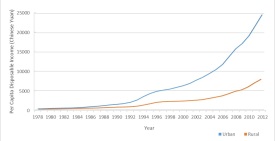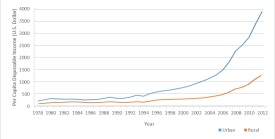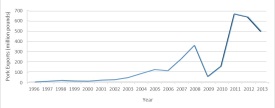
The purchase of Smithfield Foods, the world's largest hog producer and pork processor, by China’s top pork products company, Shuanghui International Holdings Ltd., stirred concerns about domestic pork supplies and food safety in the United States. The Smithfield acquisition will cause important changes in U.S. pork exports to China, consumer concerns about food safety of pork products, and competition in Chinese and U.S. pork markets.

Source: National Bureau of Statistics of
China, 2014.

Source: National Bureau of Statistics of
China, 2014; Fxtop Company, 2014.

Source: U.S. Department of Agriculture,
2014b.
Chinese demand for meat products including pork has continued to increase as the per capita disposable income in China has kept rising over the past several decades (Figure 1a and 1b). In 2012, the per capita pork consumption of Chinese urban residents (21.23 kilograms or 46.8 pounds) was similar to U.S. per capita consumption (45.9 pounds) while Chinese rural residents’ per capita pork consumption (14.4 kilograms or 31.75 pounds) was significantly lower than the U.S. consumption level (National Bureau of Statistics of China (NBSC), 2014; U.S. Department of Agriculture (USDA), 2014a). In addition, Chinese consumers have a stronger taste preference towards pork than meat products from other animal origins. Pork accounted for 59% of meat consumption by Chinese urban residents and 69% for rural residents in 2012 (NBSC, 2014). Because the income of Chinese residents will continue to increase and pork is their preferred meat, Chinese demand for pork has significant growth potential. To meet the rising demand, Chinese producers have expanded their production and China has imported more pork from other countries, especially the United States. Figure 2 shows that U.S. pork exports to mainland China have increased from 2.33 million pounds in 1996 to 496.59 million pounds in 2013, and the average annual growth rate is 34.7% (USDA, 2014b). Chinese pork production and consumption increased from 50.71 and 50.8 million metric tons in 2010 to 55.6 and 56.1 million metric tons, respectively, in 2013. Imports accounted for only 0.8-1.4% of Chinese pork consumption during the 2010-2013 period (USDA, 2014c). So China has been satisfying its increased demand primarily through increased domestic production. However, it will be difficult for China to maintain this tradition of self-sufficiency in pork as feed costs rise, and land for additional pork production becomes scarce and expensive (Gale, Marti, and Hu, 2012). China will increase its reliance on imports to satisfy its increasing demand for pork in the future.
The United States exported 638.8 million pounds of pork to China in 2012, which accounted for 39.7% of Chinese pork imports and 0.54% of Chinese pork consumption (USDA, 2014b and 2014c). Smithfield’s pork production accounted for 27.9% of total U.S. production, and about 4.5% of Smithfield’s pork products were exported to China in 2012. Smithfield’s pork exports to China accounted for 18.2% of total Chinese imports and 0.25% of Chinese pork consumption (Smithfield Foods, 2012; Mattioli, Cimilluca, and Kesmodel, 2013; and USDA, 2014c). Most of Smithfield’s exports to China have been offal; one objective of the merger is to boost exports of muscle meat. China bans the use of a feed additive known as ractopamine in pork production. Ractopamine-free pork products account for about 40% of Smithfield’s production (Bloomberg News, 2013). If Smithfield exports all its ractopamine-free pork products to China, its exports to China will increase by 788% and account for 2.2% of Chinese pork consumption. Collectively, these numbers indicate there is significant potential for Smithfield and other U.S. pork companies to increase their exports to China.
To protect domestic pork producers and maintain food self-sufficiency, the Chinese government has used various measures including import tariffs, regulations as potential technical barriers to trade, and subsidies to support production and limit imports (Hayes, 2013). One import regulation is China’s restriction on the use of Codex-approved veterinary drugs in hog production (Stuart and Fritz, 2013). In August 2014, China announced a ban on pork imports from six U.S. processing plants and six cold storage facilities due to the presence of ractopamine in their pork products (Waters and Davis, 2014). Due to high domestic production costs and import protections, hog and pork prices in Chinese markets are usually much higher than in U.S. markets. For example, the hog price in China was 40% to 100% higher than that in the United States during the time period from January 2010 to July 2013 (U.S. Meat Export Federation, 2014).
The acquisition of Smithfield by Shuanghui can lead to more U.S. pork exports to China through four channels.
First, the acquisition can give an incentive to the Chinese government to allow more pork imports from the United States. After Smithfield became a subsidiary of a Chinese company, future pork imports from the United States will be treated as less threatening to the policy goal of Chinese food self-sufficiency and the protection of its domestic producers. Thus, the Chinese government may gradually relax some restrictions and lower import duties on pork imports from the United States.
Second, the major purpose of the acquisition was to bring more U.S. meat products to China. Shuanghui chairman Wan Long indicated this purpose clearly in the announcement of the Smithfield deal (Gara, 2013). Chinese consumers’ preferences for taste and freshness of meat products are different from those of U.S. consumers (Anderson et al., 2011; and Oh and See, 2012). However, mostly due to various safety issues and scandals surrounding some Chinese food products, imported food products from developed countries, such as U.S. pork products, are viewed as higher quality products and receive positive receptions in Chinese markets (Ortega, Wang, and Wu, 2009; Wang, 2012; and Jin and Zhang, 2014). Because Chinese consumers have become increasingly conscious about the safety and quality of food products, the merged company has an incentive to increase the volume and share of the exports of Smithfield’s pork products to China and reduce the share of Shuanghui’s lower-quality Chinese products in the merged company’s total sales in Chinese markets. The coordination of these decisions did not exist before the merger.
Third, Shuanghui’s distribution network and market information in China will significantly help increase the sales of Smithfield’s pork products in China. Shuanghui is the largest pork producer in China and slaughters more than 15 million pigs a year. Shuanghui has meat processing plants in 18 of 34 province-level administrative divisions and more than 300 distribution and marketing centers in 31 province-level divisions of China. Shuanghui was set up in 1958 and has accumulated tremendous information and knowledge about Chinese consumers (Shuanghui Development, 2014). Smithfield’s pork exports to China will benefit from Shuanghui’s network and information.
Fourth, more byproducts from pork production will be exported to China after the acquisition. There are huge taste differences of pork byproducts between U.S. and Chinese consumers. Various byproducts such as feet, ears, stomachs, livers, and intestines are widely used in Chinese cuisine. The market values of these byproducts are much higher in Chinese markets than in U.S. markets. After the acquisition, the coordination between the decision on Smithfield’s exports to China and the decision on Shuanghui’s supply of Chinese products in Chinese markets will also cause the merged company to increase Smithfield’s exports of pork byproducts to China. Shuanghui will help Smithfield design the pork byproducts better suited for Chinese consumers so that more of Smithfield’s byproducts will be exported to China.
More U.S. exports to China has implications for U.S. producers and consumers. Pork prices in U.S. markets will increase. A potentially interesting aspect is that, when U.S. firms obtain additional revenue from increased sales of pork byproducts to China, they may be more willing to accept lower prices of pork meat products in U.S. markets, compared with the pre-acquisition price levels. However, this negative price effect will be outweighed by the positive effect on U.S. pork meat prices of more exports of U.S. pork products to China. The prices of U.S. pork products in Chinese markets will be affected by more supply of imported products from the United States; more demand due to income growth in China; and the new, coordinated selling strategy of the merged company for two types of differentiated products—higher-quality, imported products from Smithfield and lower-quality, domestic products from Shuanghui’s plants in China. The larger supply of imported products from the United States will reduce the prices of U.S. pork products in Chinese markets while more demand due to income growth and the new, coordinated selling strategy of the merged company will raise the prices so that the net price effect will depend on the relative magnitudes of these two opposite effects. However, the prices of U.S. pork products in Chinese markets will continue to be higher than the prices in U.S. markets. Larger total volume of U.S pork products sold in U.S. and Chinese markets—and higher pork prices in U.S. markets—will lead to more demand and higher prices of hogs in U.S. markets. U.S. consumers will be affected by changes in pork prices. More exports of U.S. pork products to China will reduce the pork supply in U.S. markets. However, hog and pork producers in the United States will also respond by expanding their production, which will increase the market supply. So the pork prices in U.S. markets will rise due to more exports to China, but the increase will be limited.
U.S. consumers may have more food safety concerns about pork products, especially Smithfield’s products, after the acquisition by Shuanghui. The concerns come from the negative impression of U.S. consumers about China’s food industry overall rather than Shuanghui itself. Many food safety incidents have occurred in China since its economic reforms in the late 1970s, and especially in the recent decade. The one receiving the most media attention was the case of contaminated baby formula in 2008. Baby formula produced by a major milk supplier, Sanlu Group, was contaminated by melamine. As a result, six children died and about 294,000 children were sick. Other food safety incidents include poisonous ham treated with the pesticide Dichlorvos in 2003, counterfeit alcoholic drinks in 2009, clenbuterol-tainted pork in 2011, and dead pigs drifting in the Huangpu River after a crack-down on illicit trade of dead meat in 2013. Shuanghui itself was implicated as one of the companies involved in the clenbuterol-tainted pork incident although Shuanghui’s responsibility is limited and indirect because the scandal was at the hog-production rather than processing level (Gara, 2013). The negative perception of U.S. consumers is expected to continue as long as food safety in China is perceived not to be significantly improved.
Food safety concerns of U.S. consumers about Smithfield’s pork products after the acquisition could adversely affect the sales and prices of Smithfield’s products, although the impact is expected to be small and its exact magnitude is a topic for future studies. The negative effect of food safety concerns on the sales and prices of the entire U.S. pork industry will be even smaller because some U.S. consumers will switch to other companies’ pork products if they are concerned about the safety of Smithfield’s products. In addition, if there are any food safety incidents related to the Chinese meat industry and Shuanghui in the future, the incidents will remind U.S. consumers of the safety concerns and cause some fluctuations in prices and sales in U.S. pork markets.
| Year | Four-Firm Concentration (%) |
Number of Slaughter Plants |
| 1980 | 34 | |
| 1995 | 46 | |
| 2000 | 56 | |
| 2001 | 57 | |
| 2002 | 55 | 175 |
| 2003 | 64 | 154 |
| 2004 | 64 | 166 |
| 2005 | 64 | 163 |
| 2006 | 61 | 159 |
| 2007 | 65 | 165 |
| 2008 | 65 | 126 |
| 2009 | 63 | 134 |
| 2010 | 65 | 129 |
| 2011 | 64 | 136 |
The four-firm concentration ratio of the U.S. pork-packing industry has increased from 34% in 1980 to 64% in 2012, and the number of hog slaughter plants has declined (Table 1) (USDA, 2012 and 2013). In addition, alternative marketing arrangements including various contracts have been increasingly used to procure live hogs. These trends have raised concerns about the anticompetitive effects of potential buyer power in hog procurements and seller power in pork markets (Zheng and Vukina, 2009). The acquisition of the United States’ largest pork producer by the top Chinese pork company has only heightened concerns about market concentration.
Initially, the acquisition of Smithfield by Shuanghui will not change the structure or concentration of either the U.S. or Chinese hog and pork markets. However, over time, the U.S. and Chinese pork markets will become more interdependent. The Smithfield acquisition by Shuanghui and future increased Smithfield exports to China will lead to a higher concentration in Chinese pork markets. Pork prices in China will not necessarily be higher because more imports from a low-price country (the United States) can lower the price in the importing country (China) and this price reduction due to the benefit of trade can offset the price effect of higher concentration. However, when pork markets in the two countries become more interdependent and major companies are selling in both countries, more concentrated and less competitive Chinese pork markets provide an alternative outlet for U.S. pork products and, thus, reduce the competition in U.S. pork markets.
The merged company will implement its within-company coordination of selling strategies of lower-quality Chinese products from Shuanghui and higher-quality imports from Smithfield in Chinese markets in order to compete with other companies. At the same time, Smithfield’s selling strategies in U.S. markets will be affected by this merged company’s new within-company coordination of selling strategies in Chinese markets. In response to the new selling strategies, other U.S. and Chinese pork companies will adjust their selling strategies accordingly, changing the nature of competition in the markets.
Given the possible increasing concentration in Chinese pork markets, more interdependence between U.S. and Chinese markets, and the coordination of selling strategies, the acquisition will likely lessen competition among companies in Chinese and U.S. pork markets. A major question for the future will be how this reduced competition will play out for U.S. consumers in pork markets.
Anderson S., C. Bieroth, G. Tucker, and T. Schroeder. 2011. “Chinese Beef Consumption Trends: Implications for Future Trading Partners.” Department of Agricultural Economics MF-3000, Kansas State University. Available online: http://www.agmanager.info/livestock/marketing/bulletins_2/industry/demand/MF3000.pdf.
Bloomberg News, 2013, October 9 “Smithfield to Cut Hog-Feed Additive to Boost Exports to China.” Available online: http://www.bloomberg.com/news/2013-10-10/smithfield-to-cut-hog-feed-additive-to-boost-exports-to-china.html.
Fxtop Company. 2014. Historical Official Exchange Rates. Available online: http://fxtop.com/en/historical-exchange-rates.php?MA=1.
Gale, F., D. Marti, and D. Hu. 2012. China’s Volatile Pork Industry. Washington, D.C.: U.S. Department of Agriculture, Economic Research Service, Outlook No. (LDPM-21101), February. Available online: http://www.ers.usda.gov/publications/ldpm-livestock,-dairy,-and-poultry-outlook/ldpm211-01.aspx.
Gara, T. 2013, May 29 “The Smithfield Deal: China Bringing Home the American Bacon.” The Wall Street Journal. Available online: http://blogs.wsj.com/corporate-intelligence/2013/05/29/the-smithfield-deal-china-bringing-home-the-american-bacon/.
Hayes, D. 2013. “Prospects for US-China Trade in Meat Products and Associated Investment Opportunities.” Paulson Papers on Investment: Agribusiness Series, The Paulson Institute, July. Available online: http://www.paulsoninstitute.org/media/103128/us-china_trade_and_investment_in_meat_hayes_english.pdf.
Jin, S., and Y.Y. Zhang. 2014. “The Value of “Made in USA”: Impact of Chinese Acquisition of a U.S. Company on Consumer Willingness to Pay.” Paper presented at Agricultural and Applied Economics Association annual meeting, Minneapolis, Minn., July.
Mattioli, D., D. Cimilluca, and D. Kesmodel. 2013, May 30 “China Makes Biggest U.S. Play.” The Wall Street Journal. Available online: http://online.wsj.com/news/articles/SB10001424127887324412604578512722044165756.
National Bureau of Statistics of China. 2014. China Statistical Yearbook, 2013. Beijing. Available online: http://www.stats.gov.cn/tjsj/ndsj/2013/indexeh.htm.
Oh, S.H., and M.T. See. 2012. “Pork Preference for Consumers in China, Japan and South Korea.” Asian-Australasian Journal of Animal Sciences 25: 143–150.
Ortega, D.L., H. Wang, and L. Wu. 2009. “Food Safety and Demand: Consumer Preferences for Imported Pork in Urban China.” Journal of Food Distribution Research 40(3): 52–63.
Shuanghui Development. 2014. “About Shuanghui.” Available online: http://www.shuanghui.net/html/category/about/qyjs.
Smithfield Foods. 2012. Smithfield Integrated Report, 2012. Available online: http://www.smithfieldfoods.com/media/12902/smithfield-integrated-report-2012.pdf.
Stuart, B.W., and R.G. Fritz. 2013. “China’s Impact on U.S. Poultry and Livestock Sectors.” Choices 28(1): 1–5.
U.S. Department of Agriculture. 2012. 2011 Annual Report: Packers and Stockyards Program. Grain Inspection Packers and Stockyards Administration, Washington, D.C., March.
U.S. Department of Agriculture. 2013. 2012 Annual Report: Packers and Stockyards Program. Grain Inspection Packers and Stockyards Administration, Washington, D.C., March.
U.S. Department of Agriculture. 2014a. USDA Agricultural Projections to 2023. Economic Research Service Long-term Projections Report OCE-2014-1, Washington, D.C., February. Available online: http://www.usda.gov/oce/commodity/projections/USDA_Agricultural_Projections_to_2023.pdf.
U.S. Department of Agriculture. 2014b. Livestock & Meat International Trade Data. Economic Research Service, Washington, D.C., December. Available online: http://www.ers.usda.gov/data-products/livestock-meat-international-trade-data.aspx#26019.
U.S. Department of Agriculture. 2014c. Livestock and Poultry: World Markets and Trade. Foreign Agricultural Service, Washington, D.C., October. Available online:
http://www.fas.usda.gov/data/livestock-and-poultry-world-markets-and-trade.
U.S. Meat Export Federation. 2014. “China’s Hog, Pork Prices Still Climbing.” Available online: https://www.usmef.org/chinas-hog-pork-prices-still-climbing/.
Wang, H. 2012, August 22 “Consumers turn toward imported food.” China Daily. Available online: http://www.chinadaily.com.cn/business/2012-08/22/content_15694718.htm.
Waters, T., and M. Davis. 2014, August 12 “China halts some U.S. pork imports over feed additive use.” Reuters. Available online: http://www.reuters.com/article/2014/08/12/us-china-pork-additive-idUSKBN0GC20Y20140812.
Zheng, X., and T. Vukina. 2009. “Do Alternative Marketing Arrangements Increase Pork Packers’ Market Power?” American Journal of Agricultural Economics 91: 250–263.